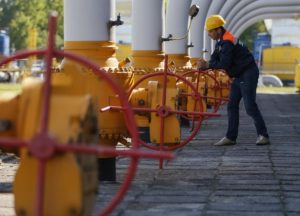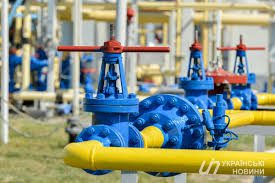NJSC Naftogaz Ukrainy in July will cut the price of natural gas for the needs of households by 8% compared with the price in June, to UAH 5,803 per 1,000 cubic meters (VAT and transportation and distribution costs not included), Chairman of Naftogaz Executive Board Andriy Kobolev has written on his Facebook page.
“Gas on the international market is becoming cheaper again. Thanks to this, Naftogaz reduces gas prices for industrial consumers by almost 8% in June. According to the government’s decision, the price of Naftogaz for commercial consumers forms the price of gas for households that is valid next month,” he wrote.
As reported, Cabinet of Ministers resolution No. 867 dated October 19, 2018 extended the period of validity of public service obligations (PSO) for Naftogaz to sell natural gas for the needs of the households, producers of heat energy and religious organizations until May 1, 2020.
The situation on the European market since spring 2019 has led to a decrease in the market price of gas below the government-set regulatory level for households.
The government made amendments, according to which, under PSO, the prices of gas for households and heat suppliers is calculated as the average price of gas supplied by Naftogaz to industrial consumers that was in effect in the month preceding the month of delivery.

Ukraine from April 4 through May 25, 2019 increased natural gas stocks in its underground storage facilities by 25.7% or 2.25 billion cubic meters (bcm), to 10.996 bcm, according to recent update from JSC Ukrtransgaz.
According to the calculations of the Interfax-Ukraine agency, the figure is 19% more than stocks on May 25, 2018 and 13.8% more than on May 25, 2017.
On May 25, 2019, 77.14 million cubic meters (mcm) of gas was pumped into the underground storage facilities and 52.3 mcm of gas was imported with domestic production of 57.7 mcm.
Earlier Naftogaz CEO Andriy Kobolev said that national joint-stock company Naftogaz Ukrainy is mulling a possibility of pumping an additional volume of gas to the underground gas storage facilities of Ukraine if Russia’s Gazprom stops gas transit across the country after 2019. Ukraine plans to have around 20 bcm of gas in stocksat the beginning of the next heating season.
During the heating season started on November 7, 2018 and lasted until April 4, 2019 some 8.45 bcm of gas was pumped from the underground gas storage facilities. The stocks fell from 17.195 bcm to 8.745 bcm.
Ukrtransgaz, a wholly owned subsidiary of Naftogaz Ukrainy, operates Ukraine’s gas transmission system and 12 underground gas storage facilities with 31 bcm of capacity.

Ukraine in January-March 2019 imported 1.555 billion cubic meters of natural gas for a total of $399.313 million, in particular in March 831.367 million cubic meters for $196.101 million, according to the State Statistics Service.
Thus, the average price of gas imported by the country in March 2019 was $235.9 per 1,000 cubic meters, which is 13.7% less than in February 2019 ($273.3).
The country’s contractors in the first quarter of 2019 were companies from Switzerland with 524.087 million cubic meters of gas for $131.787 million, Germany with 332.802 million cubic meters for $87.137 million, Poland with 235.554 million cubic meters for $51.566 million, Austria with 189.426 million cubic meters worth $57.046 million, France with 71.759 million cubic meters for $17.953 million, the UK with 63.022 million cubic meters for $18.525 million, Hungary with 53.457 million cubic meters worth $11.736 million, Luxembourg with 44.049 million cubic meters for $13.262 million, the Czech Republic with 39.475 million cubic meters for $9.822 million, Slovakia with 1.792 million cubic meters for $479,000, and Bulgaria with 400,000 cubic meters for $1,000.
Gas was not imported from Russia in the period.

Production of natural gas in Ukraine in January-April 2019 increased 3.6% or by 245.1 million cubic meters (mcm) year-over-year, to 7.016 billion cubic meters (bcm), according to a preliminary report of JSC Ukrtransgaz. According to the calculations of Interfax-Ukraine, gas production by JSC Ukrgazvydobuvannia amounted to 5.14 bcm (2.7% more from January-April 2018), PJSC Ukrnafta to 382.9 mcm (11.2% more), other companies to 1.493 bcm (5% up).
In April 2019, gas production amounted to 1.741 bcm (4.3% up from April 2018), in particular production by Ukrgazvydobuvannia amounted to 1.272 bcm (2.5% more), Ukrnafta to 93.7 mcm (12.9% up), and other companies to 375.9 mcm (8.5% up).

PJSC Ukrnafta in March 2019 increased oil and condensate production by 6.4% (7,700 tonnes) compared to March 2018, to 128,800 tonnes, the press service of the company has reported.
Natural gas production increased by 12.9% (11.4 million cubic meters), to 100.1 million cubic meters.
The average daily production, respectively, amounted to 4,200 tonnes of oil and 3.2 million cubic meters of gas.
As reported, according to the non-audited statements, in 2018 Ukrnafta received UAH 6.628 billion of net profit against UAH 101.771 million of profit for 2017.
Last year, the company increased its oil and gas condensate production by 5% compared with 2017, to 1.448 million tonnes. Gas production decreased by 2.3%, to 1.082 billion cubic meters, production of liquefied gas by 5.2%, to 110,000 tonnes.
GAS, OIL, PRODUCTION, UKRNAFTA

Production of natural gas in Ukraine in January and February 2019 increased by 2.8% (by 94.5 million cubic meters) compared to the same period in 2018, to 3.46 billion cubic meters, according to current data from PJSC Ukrtransgaz.
According to calculations by Interfax-Ukraine, in particular gas production by JSC Ukrgazvydobuvannia amounted to 2.542 billion cubic meters (2.7% up from January-February 2018), PJSC Ukrnafta to 189.2 million cubic meters (9.6% up), by other companies to 728.9 million cubic meters (1.5% up).
In February 2019, gas production amounted to 1.644 billion cubic meters (3.3% up compared to February 2018), in particular extraction by Ukrgazvydobuvannia was 1.207 billion cubic meters (3% up), Ukrnafta some 90.4 million cubic meters (10.7% up), other companies some 346.8 million cubic meters (2.4% up).
Ukrtransgaz, fully owned by Naftogaz Ukrainy, operates a system of trunk gas pipelines and 12 underground gas storage facilities of the country with a total capacity of 31 billion cubic meters.